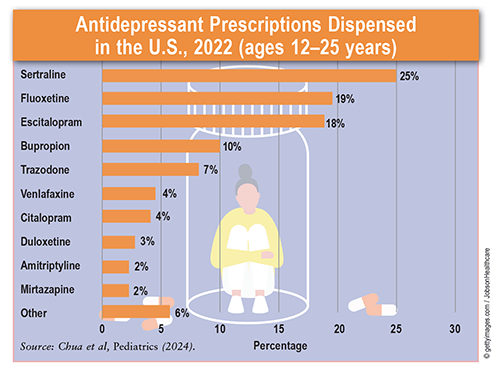US Pharm. 2024;49(5):14.
In 2021, the American Academy of Pediatrics declared a national emergency in child and adolescent mental health based on alarming increases in the rates of depression, anxiety, trauma, and suicidality. A similar decline in the mental health of young adults has also been reported throughout the United States, especially following the COVID-19 outbreak. Numerous factors have been associated with this health crisis, including social, economic, and access-to-care issues.

Antidepressant Dispensing: A recent study (Chua et al, Pediatrics, March 2024) analyzed more than 221 million antidepressant prescriptions dispensed between 2016 and 2022 that were included in the all-payer IQVIA Longitudinal Prescription Database of retail, mail-order, and long-term-care pharmacies. The monthly antidepressant-dispensing rate for U.S. adolescents and young adults aged 12 to 25 years increased by 66.3% from 2016 to 2022. Monthly rates were also 63.5% higher from March 2020 to December 2022 compared with rates prior to March 2020, when the World Health Organization declared the COVID-19 pandemic. In addition, subgroup analysis revealed that monthly antidepressant-dispensing rates for females aged 12 to 17 years (adolescents) and 18 to 25 years (young adults) were 129.6% and 56.5% higher, respectively, after March 2020 than before it. Such changes before and after the pandemic were not observed in adolescent or young adult males. Based on data trends, the overall monthly antidepressant-dispensing rate was 4% higher than expected by December 2022.
Antidepressant Prescribing: More than 67% of antidepressant prescriptions dispensed between 2016 and 2022 were selective serotonin reuptake inhibitors. The antidepressant prescriptions most commonly dispensed were sertraline (24.1%), fluoxetine (18.5%), and escitalopram (16.3%). In 2016, 35.9% of dispensed antidepressant prescriptions were prescribed by psychiatric specialty physicians, family medicine physicians (18.6%), and nurse practitioners (18.3%). By 2020, nurse practitioners were prescribing most antidepressant prescriptions (33.1%), followed by psychiatric specialty (26%) and family medicine (13.9%) physicians.
Data Sample Characteristics: Antidepressant prescriptions were dispensed to more than 18 million adolescents and young adults from 2016 to 2022. Patients’ mean age was 19.2 years, with 64.7% aged 18 to 25 years. Antidepressant therapy initiation and dispensing of at least one antidepressant prescription increased by 31% and 46.1%, respectively, during this period. About 64.3% of adolescents and young adults were female, 35.4% were male, and 0.3% were of unknown sex. Geographically, 38.6% resided in the South, 25.7% in the Midwest, 19.6% in the West, and 16.1% in the Northeast. Future studies are needed to identify drivers of this persistent U.S. mental health crisis, along with treatment approaches and patterns that mitigate short-term and long-term consequences.
The content contained in this article is for informational purposes only. The content is not intended to be a substitute for professional advice. Reliance on any information provided in this article is solely at your own risk.
To comment on this article, contact rdavidson@uspharmacist.com.





